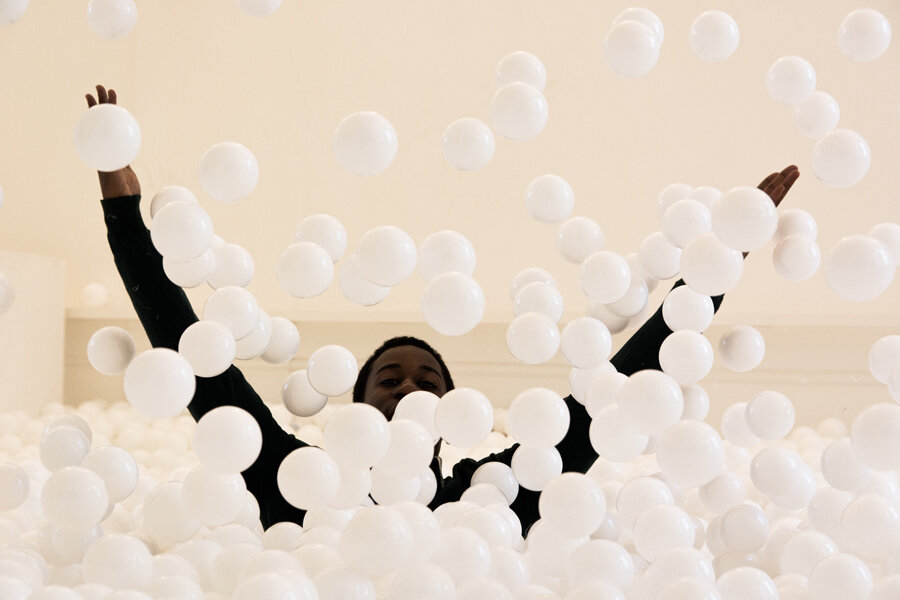Giant ball pit for adults and other fun paths to corporate creativity
Loading...
More and more companies are embracing professionals’ need for creativity, and one company in London has taken it to a new level: a giant ball pit for adults.
Creative agency Pearlfisher opened a pop-up ball pit in Hammersmith that will be open until mid-February. The pit features 81,000 balls and can fit up to 30 people at a time. Sound overwhelming? The opted out of the traditional rainbow-colored pit and went for a nice calming, utopian white, according to The Independent.
Sarah Codraro, a spokesperson for Pearlfisher, said in an email to The Christian Science Monitor that the installation has been inundated with booking requests and is already fully booked. She said the goal of the installation was to highlight the importance of play in promoting creativity, its transformative power, and the future of "work being play."
"The fact that we've been inundated with requests shows there's a real desire and need for this in our daily lives and I think that's very interesting in itself!" Ms. Codraro said in an email.
The idea of fostering creativity in the workplace has become more mainstream in the last few years. Google, one of the most progressive companies in transforming workspaces, strives “to create the happiest, most productive workplace in the world,” according to Google spokesman Jordan Newman.
Their offices feature a labyrinth of designed “play areas” that model old theaters, secret reading rooms, and old trolley cars. Employees are allowed to design their own desks and write on the walls, a look The New York Times described as “some kind of high-tech refugee camp,” but an atmosphere appreciated by the engineers nonetheless.
Other CEOs have also experimented with ways to foster creativity in the workplace. Marissa Mayer, CEO of Yahoo, earned a lot of praise and criticism last year when she enacted a ban on employees working from home. While employees argued that it affected their productivity, others pointed to studies that show that the simple act of being around one another fosters employees’ creativity and potential for innovation.
“Some of the best decisions and insights come from hallway and cafeteria discussions, meeting new people and impromptu team meetings. Speed and quality are often sacrificed when we work from home,” wrote Jackie Reses, Yahoo’s director of human resources, in a memo.
Regina Dugan, formerly of the Defense Advanced Research Projects Agency (DARPA) and now an executive at Google, is another pioneer in enabling creative pathways in the corporate environment. In the workplace, she hires intelligent people, encourages them to focus on basic science and practical application across disciplines and without fear. She notes that researchers must embrace childlike creativity rather than avoid looking foolish.
“We cannot fear failure and create new and amazing things,” Ms. Dugan said, reported The Christian Science Monitor in a previous story. The freedom to explore can be among a company’s most valuable assets.
Sometimes the key to innovation can be found in embracing a childlike mindset, as evidenced by 12-year-old Shubham Banerjee, who developed a braille printer using programmable Lego robot kits. Kids sometimes have an advantage to adults in the sense that they are free from locked thinking habits, and therefore able to access their creativity more readily.
“Kids’ brains are not fully developed at the age of this young inventor [Mr. Banjeree] and what’s great about that is the flexibility and the ability to tap into creative play for problem solving,” said Kristin J. Carothers, clinical psychologist at the Child Mind Institute in New York. “As we get older, we do less and less creative play, get set in our thought patterns, and lose that ability to a great extent.
“You don’t have to have a slide in the middle of your office in order to regain that kind of creative thinking process,” Carothers explained. “You need to be mindful of taking mind breaks, not just standard lunch breaks. Watch a YouTube video. Play a game. Read a book. Take your mind out of the box.”
Or – if you find yourself in London – take a dip in the ball pit.






